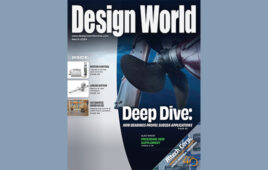In this issue:
22 Energy efficiency in LLC resonant conversion topologies
37 Better thermal design means better efficiency
Energy efficient doesn’t mean cost efficient
 I once had a root cellar illuminated by a single incandescent light bulb, the kind of bulb that is being phased out thanks to energy efficiency regulations. I would use that light bulb perhaps 15 minutes over the span of a year. When it burned out, DOE regulators would have had me replace it with a compact fluorescent bulb costing about five times as much as the original incandescent. Turned on only 15 minutes/year, there was no way the increased efficiency of the CFL bulb would ever make up for its price tag.
I once had a root cellar illuminated by a single incandescent light bulb, the kind of bulb that is being phased out thanks to energy efficiency regulations. I would use that light bulb perhaps 15 minutes over the span of a year. When it burned out, DOE regulators would have had me replace it with a compact fluorescent bulb costing about five times as much as the original incandescent. Turned on only 15 minutes/year, there was no way the increased efficiency of the CFL bulb would ever make up for its price tag.
I recalled this incident when reviewing a recent report on whether energy efficiency regulations put in place by the Dept. of Energy are worth what they cost. DOE efficiency regulations now apply to everything from refrigerators and water heaters to lamp ballasts and electric motors. The Office of Information and Regulatory Affairs (OIRA) says these mandates have posed the third-highest cost burden on U.S. citizens from 2002 to 2012 of any regulatory agency, behind only those from the DoT and EPA.
Of course, costs are OK if their benefits more than pay for them. DOE’s own estimates are that from 2007 to 2015 its regulations have cost $9.5 billion but have brought $32 billion in benefits. The problem, points out a think tank called the American Action Forum, is that both figures are subject to a large amount of uncertainty. One issue is that they are based on economic models rather than on real data. The economic models use a discount rate to figure out whether money spent today on more efficient products will be earned back from benefits over time because of lower energy use. But scholars from the George Washington Regulatory Studies Center who have looked at DOE regulatory assumptions have found that small adjustments in the discount rates can turn a rule with benefits into something that costs more than it’s worth.
More worrisome, says AAF, there is no such thing as a “peer review” outside the DOE for the assumptions that go into economic models justifying rules. That leads to energy regulations that are on shaky ground economically.
Fortunately, some energy regulations have been in place long enough for scholars to study what actually happens when they’re implemented rather than what models predict. The results aren’t promising.
In one case, National Bureau of Economic Research scholars looked at more than 30,000 households that had participated in a DOE weatherization assistance program. The researchers found the upfront investment costs to be about twice the actual energy savings.
Big surprise: The economic model DOE used to justify the program turned out to be flawed. It projected savings of about 2.5 times what was actually realized. Even worse, those who participated in the program didn’t seem to be any warmer in the winter. NBER scholars found no evidence of significantly higher indoor temperatures at weatherized homes. And even when accounting for the broader societal benefits of energy efficiency investments, they say, the costs still substantially outweigh the benefits; the average rate of return is approximately -9.5% annually.
I suspect that roughly the same rate of negative return applies when incandescent bulbs used a few minutes annually get replaced with much more expensive energy efficient versions.
Power & Energy Efficiency Handbook Digital Edition
Filed Under: DIGITAL ISSUES • DESIGN WORLD, DIGITAL ISSUES • EE WORLD





Today you can buy LED bulbs at 99 cent stores. You can also buy 2 incandescent bulbs for about the same price. The authors thinking only applies to the bulb used in his cellar. What about all of his other bulbs; the porch light, the bedroom and bathroom lights, and so-on and so-on. When I starting installing CFL’s back in the 90’s I never put a bulb in a closet or garage door opener, or anyplace where the bulb would rarely be used, or when used only on for a few minutes at a time. I put those more expensive bulbs in applications where the lights were only many hours each day.
Fast forward to 2016 and LED bulbs cost almost as much as incandescent bulbs. Why would you want to install an incandescent bulb instead of an LED at similar price points. The only reason I see for keeping some incandescent bulbs around is when the heat from the bulb is more important than the light output. Remember you can cook with an incandescent bulb in one of those play ovens for kids.
I suggest you give LEDs a try. For energy efficiency, CFL’s are as outdated as VHS tapes.
This was back in the days when there was no such thing as a 60-W equivalent LED bulb. Even so, with LED bulbs costing around $5 and 60-W incandescents running 50 cents or so, I still couldn’t justify putting a high-efficiency bulb in there.
Fast forward to 2016 and there is no way an LED bulb is at a “similar price point” to an incandescent bulb. The cheapest LED bulb I’ve seen costs about $3 plus shipping. The LED bulbs at my local home improvement store run at least $5 and up. Meanwhile, a 60-W incandescent runs fifty cents at my local drug store. BTW, the 20-year lifetimes often quoted for LED bulbs are also probably a myth. Dissect most LED bulbs and you will find an electrolytic capacitor buried in the electronics. These things are quite heat sensitive, and most of the LED bulbs I’ve seen do get quite hot. Thus the limiting factor for a lot of bulbs will be the lifetime of the electrolytic capacitor, not the lifetime of the LEDs.